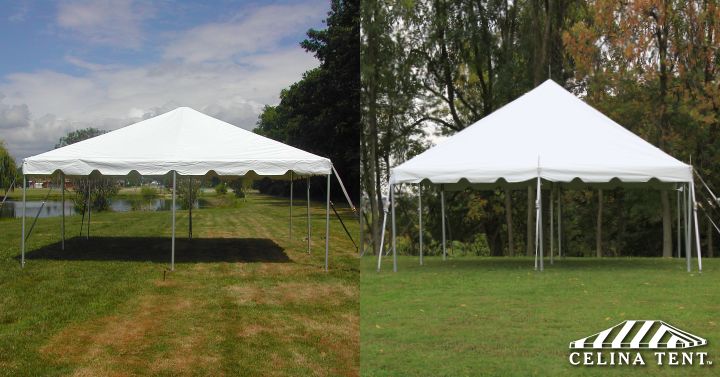It seems like such a simple distinction – Pole Tents use poles to stay up, and Frame Tents have a frame. Question answered!
Sort of.
Ask any rental group or tent owner and you can get a complete run down of the work included with each type, from installation times to the amount hardware that you need to take from place to place. The differences are actually pretty striking, even between tents of the same size. How different, you’re asking yourself right now? Let’s have a friendly competition!
TEST 1: Amount of Hardware
This one is pretty straight forward – while a pole tent will have side poles, center poles, and the tent top fabric, a frame tent will include legs, perimeter tubing, rafter tubing, fittings for corners and leg locations, and the fasteners used to keep them all together. If space is at a premium for your storage or transport, it may behoove you to go with pole tents just to keep out of the fiddly-little-bits arena.
POINT: Pole Tents
TEST 2: Appearance
Ah, the decoration round. I mean appearance round. We have the sloping, graceful pole tent top and the squared, strong building-like build of the frame tent. How can we choose between the two, when it’s all so dependent on personal preference? We can’t.
POINT: Tie
TEST 3: Tent Footprint
Each tent style has the same anchoring, with guy lines running out from the leg locations and attaching to the stakes. Leg locations are also the same, with a support every five feet along the perimeter of the tent. Inside the tent, however, is the big difference. To remain aloft, pole tents require center poles that create the high points of the sloping top. Frame tents, with the system of rafters and fittings, have no obstructions within the tent whatsoever.
POINT: Frame Tents
TEST 4: Ease of Setup
Now we compare the part that no one enjoys about installations: the actual work. Focusing on frame tents, the majority of your time is going to be spent assembling the roof frame. Corner and Side Tee fittings, spreaders, rafters, and crowns all need to be connected using the fasteners you have (r-pin, pin and bail, or bolts). Then the top fabric is pulled over your assembled framework, and the entire assembly is lifted to install the leg tubing (same fastening) and connecting all anchoring guy lines.
When you have a pole tent, you’ll just have to spread out your top once your perimeter staking is installed, and then angle in the corner and center poles. Once that far, you need to lift it all into place and installing every side pole, tensioning the anchoring guy lines as you go to ensure even tension across your top (since this tension is what is keeping your tent in place). Tension needs to be double checked after all of the pieces are installed to make sure the tent won’t pocket under rain or water, and to double check the stability of the tent.
Hmmm …. That seems about equal again. Who’d have thought?
POINT: Tie
* * *
Interesting … we weren’t really expecting a tie. It seems that when you really get into the gritty details, it may be best to simply choose which aspects are more important to you. If you’re really interested in have less pieces to deal with, pole tents may be your best bet. For those really needing every bit of tent space for tables, displays, and more, maybe a frame tent is your option.
As always, if you’d like to talk with one of our account
managers we can be reached at +44 115 794 0041. We’d be happy to answer any
questions you may have – give us a call!

Frame versus Poles: Which Tents are You After?